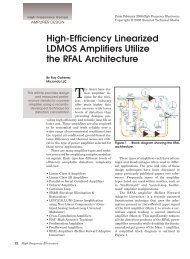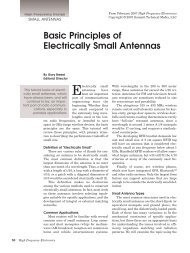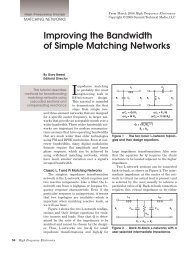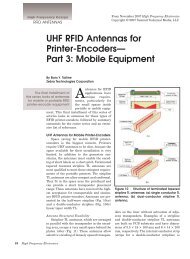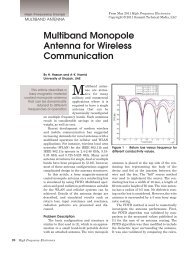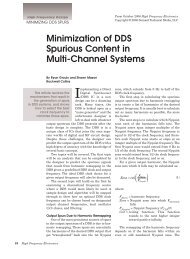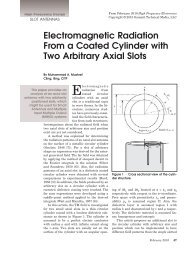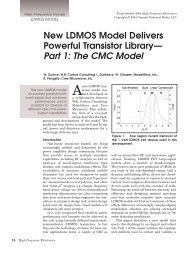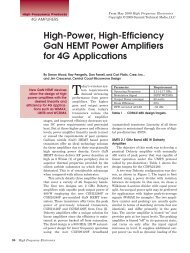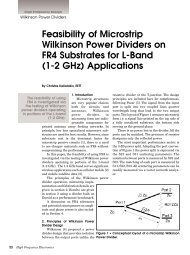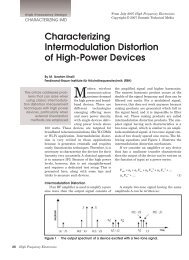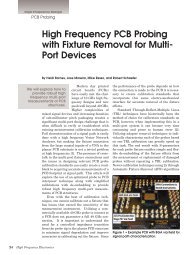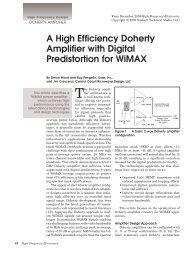PcB - High Frequency Electronics
PcB - High Frequency Electronics
PcB - High Frequency Electronics
Create successful ePaper yourself
Turn your PDF publications into a flip-book with our unique Google optimized e-Paper software.
EDITORIAL<br />
Vol. 11 No. 8, August 2012<br />
Publisher<br />
Scott Spencer<br />
scott@highfrequencyelectronics.com<br />
Tel: 603-472-8261<br />
Associate Publisher/Managing Editor<br />
Tim Burkhard<br />
tim@highfrequencyelectronics.com<br />
Tel: 707-544-9977<br />
Senior Technical Editor<br />
Tom Perkins<br />
tom@highfrequencyelectronics.com<br />
Tel: 603-472-8261<br />
Vice President, Sales<br />
Gary Rhodes<br />
grhodes@highfrequencyelectronics.com<br />
Tel: 631-274-9530<br />
Editorial Advisors:<br />
Ali Abedi, Ph.D.<br />
Candice Brittain<br />
Paul Carr, Ph.D.<br />
Alen Fezjuli<br />
Roland Gilbert, Ph.D.<br />
Sherry Hess<br />
Thomas Lambalot<br />
John Morelli<br />
Karen Panetta, Ph.D.<br />
Business Office<br />
Summit Technical Media, LLC<br />
One Hardy Road, Ste. 203<br />
PO Box 10621<br />
Bedford, NH 03110<br />
Also Published Online at<br />
www.highfrequencyelectronics.com<br />
Subscription Services<br />
Sue Ackerman<br />
Tel: 651-292-0629<br />
circulation@highfrequencyelectronics.com<br />
Send subscription inquiries and address changes<br />
to the above contact person. You can send them<br />
by mail to the Business Office address above.<br />
Our Environmental Commitment<br />
<strong>High</strong> <strong>Frequency</strong> <strong>Electronics</strong> is printed<br />
on paper produced using sustainable<br />
forestry practices, certified by<br />
the Program for the Endorsement<br />
of Forest Certification (PEFC),<br />
www.pefc.org<br />
Copyright © 2012, Summit Technical Media, LLC<br />
6 <strong>High</strong> <strong>Frequency</strong> <strong>Electronics</strong><br />
Summer Gives Time to<br />
Pause and Reflect<br />
Tom Perkins<br />
Senior Technical Editor<br />
While attending the IEEE International<br />
Microwave Symposium in June, and observing<br />
folks using all sorts of mobile transmit/receive<br />
devices, a thought occurred that was revelatory if somewhat<br />
nerd-like. These people were nonchalantly communicating<br />
using a subset of microwave technology that, in<br />
itself, was at best only imagined just a few decades ago.<br />
Of course one could include consideration of cartoon<br />
detective Dick Tracy’s Two-Way Wrist Radio (early 1946).<br />
I’m not sure those small radios pretended to use microwave frequencies, and<br />
use of simplex (no repeaters) was probably all that was contemplated, but<br />
the idea did predate invention of the transistor at Bell Labs in 1947. This<br />
wrist-radio cartoon fantasy was alleged to have been inspired by Alfred J.<br />
Gross, inventor of a walkie-talkie in 1937. Mr. Gross is thought to have been<br />
born too early, as his patents expired prior to the widespread use of two-way<br />
portable devices. He also developed pagers—remember those? Incidentally,<br />
in 1964 Dick Tracy’s radio was replaced with a two-way wrist TV. One wonders<br />
if it was a digital, high-definition flat-screen display?<br />
Useless Frequencies—Not!<br />
What attendees at the conference and millions worldwide now do routinely<br />
with relatively inexpensive and very reliable consumer equipment<br />
was cutting-edge subject matter in talks and exhibits only a few years ago.<br />
In fact, just the thought of thousands of users performing all kinds of routine<br />
enabling tasks simultaneously in a small area sharing the electromagnetic<br />
spectrum is mind-boggling. A mere live point-to-point microwave transmission<br />
outside the confines of a radar range or laboratory would have drawn<br />
considerable attention only two decades ago. Now it occurs all around us,<br />
24/7. Less than 100 years ago wavelengths shorter than 200 meters (1500<br />
KHz) were generally considered useless. The higher frequencies (short<br />
wavelengths) were left to “radio amateurs” to explore. Weigh that fact in<br />
contrast to the now-widespread use of millimeter-wave technology and the<br />
emerging use of Terahertz Technology. Now we’re working with frequencies<br />
up to at least 10,000 GHz (30 µm).<br />
What Comes Around Goes Around<br />
Many advances have enabled widespread wireless technology.<br />
Interestingly, the term “wireless” has made a comeback from the early<br />
“spark gap” transmitter days. Unquestionably, solid-state technology,<br />
accompanied by numerous breakthroughs in RFICs, synthesizers, digital<br />
circuitry, advanced communications techniques, materials science, satellites,<br />
antennas, long-life rechargeable batteries, computers, sophisticated<br />
design software, standards and regulations, to name a few, have enabled



